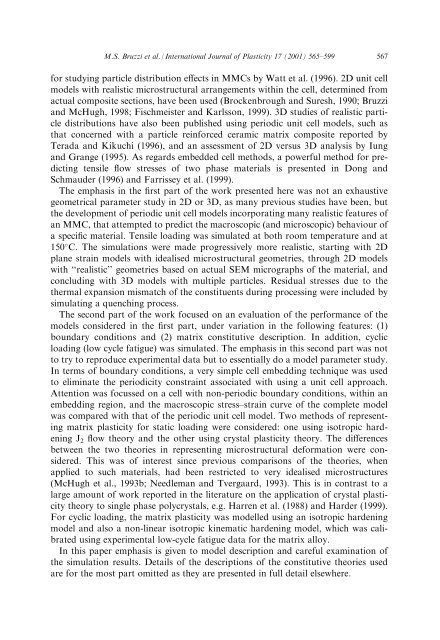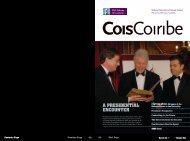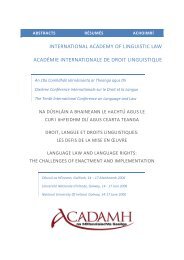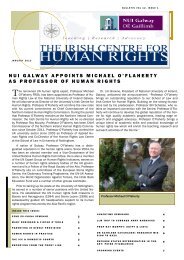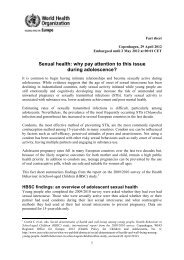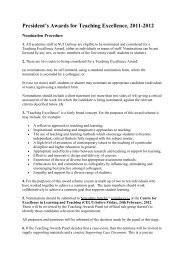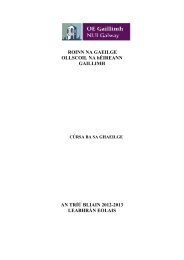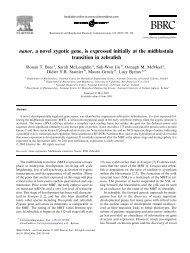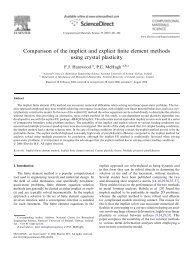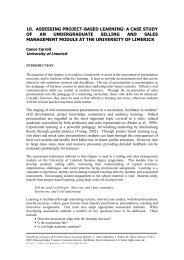Micromechanical modelling of the static and cyclic ... - ResearchGate
Micromechanical modelling of the static and cyclic ... - ResearchGate
Micromechanical modelling of the static and cyclic ... - ResearchGate
Create successful ePaper yourself
Turn your PDF publications into a flip-book with our unique Google optimized e-Paper software.
M.S. Bruzzi et al. / International Journal <strong>of</strong> Plasticity 17 (2001) 565±599 567<br />
for studying particle distribution e€ects in MMCs by Watt et al. (1996). 2D unit cell<br />
models with realistic microstructural arrangements within <strong>the</strong> cell, determined from<br />
actual composite sections, have been used (Brockenbrough <strong>and</strong> Suresh, 1990; Bruzzi<br />
<strong>and</strong> McHugh, 1998; Fischmeister <strong>and</strong> Karlsson, 1999). 3D studies <strong>of</strong> realistic particle<br />
distributions have also been published using periodic unit cell models, such as<br />
that concerned with a particle reinforced ceramic matrix composite reported by<br />
Terada <strong>and</strong> Kikuchi (1996), <strong>and</strong> an assessment <strong>of</strong> 2D versus 3D analysis by Iung<br />
<strong>and</strong> Grange (1995). As regards embedded cell methods, a powerful method for predicting<br />
tensile ¯ow stresses <strong>of</strong> two phase materials is presented in Dong <strong>and</strong><br />
Schmauder (1996) <strong>and</strong> Farrissey et al. (1999).<br />
The emphasis in <strong>the</strong> ®rst part <strong>of</strong> <strong>the</strong> work presented here was not an exhaustive<br />
geometrical parameter study in 2D or 3D, as many previous studies have been, but<br />
<strong>the</strong> development <strong>of</strong> periodic unit cell models incorporating many realistic features <strong>of</strong><br />
an MMC, that attempted to predict <strong>the</strong> macroscopic (<strong>and</strong> microscopic) behaviour <strong>of</strong><br />
a speci®c material. Tensile loading was simulated at both room temperature <strong>and</strong> at<br />
150 C. The simulations were made progressively more realistic, starting with 2D<br />
plane strain models with idealised microstructural geometries, through 2D models<br />
with ``realistic'' geometries based on actual SEM micrographs <strong>of</strong> <strong>the</strong> material, <strong>and</strong><br />
concluding with 3D models with multiple particles. Residual stresses due to <strong>the</strong><br />
<strong>the</strong>rmal expansion mismatch <strong>of</strong> <strong>the</strong> constituents during processing were included by<br />
simulating a quenching process.<br />
The second part <strong>of</strong> <strong>the</strong> work focused on an evaluation <strong>of</strong> <strong>the</strong> performance <strong>of</strong> <strong>the</strong><br />
models considered in <strong>the</strong> ®rst part, under variation in <strong>the</strong> following features: (1)<br />
boundary conditions <strong>and</strong> (2) matrix constitutive description. In addition, <strong>cyclic</strong><br />
loading (low cycle fatigue) was simulated. The emphasis in this second part was not<br />
to try to reproduce experimental data but to essentially do a model parameter study.<br />
In terms <strong>of</strong> boundary conditions, a very simple cell embedding technique was used<br />
to eliminate <strong>the</strong> periodicity constraint associated with using a unit cell approach.<br />
Attention was focussed on a cell with non-periodic boundary conditions, within an<br />
embedding region, <strong>and</strong> <strong>the</strong> macroscopic stress±strain curve <strong>of</strong> <strong>the</strong> complete model<br />
was compared with that <strong>of</strong> <strong>the</strong> periodic unit cell model. Two methods <strong>of</strong> representing<br />
matrix plasticity for <strong>static</strong> loading were considered: one using isotropic hardening<br />
J 2 ¯ow <strong>the</strong>ory <strong>and</strong> <strong>the</strong> o<strong>the</strong>r using crystal plasticity <strong>the</strong>ory. The di€erences<br />
between <strong>the</strong> two <strong>the</strong>ories in representing microstructural deformation were considered.<br />
This was <strong>of</strong> interest since previous comparisons <strong>of</strong> <strong>the</strong> <strong>the</strong>ories, when<br />
applied to such materials, had been restricted to very idealised microstructures<br />
(McHugh et al., 1993b; Needleman <strong>and</strong> Tvergaard, 1993). This is in contrast to a<br />
large amount <strong>of</strong> work reported in <strong>the</strong> literature on <strong>the</strong> application <strong>of</strong> crystal plasticity<br />
<strong>the</strong>ory to single phase polycrystals, e.g. Harren et al. (1988) <strong>and</strong> Harder (1999).<br />
For <strong>cyclic</strong> loading, <strong>the</strong> matrix plasticity was modelled using an isotropic hardening<br />
model <strong>and</strong> also a non-linear isotropic kinematic hardening model, which was calibrated<br />
using experimental low-cycle fatigue data for <strong>the</strong> matrix alloy.<br />
In this paper emphasis is given to model description <strong>and</strong> careful examination <strong>of</strong><br />
<strong>the</strong> simulation results. Details <strong>of</strong> <strong>the</strong> descriptions <strong>of</strong> <strong>the</strong> constitutive <strong>the</strong>ories used<br />
are for <strong>the</strong> most part omitted as <strong>the</strong>y are presented in full detail elsewhere.


